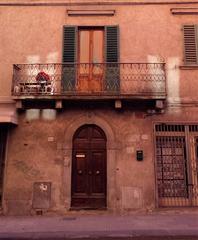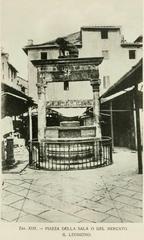Ospedale del Ceppo Pistoia: Visiting Hours, Tickets, and Historical Significance
Date: 14/06/2025
Introduction
Located in the heart of Pistoia, Tuscany, the Ospedale del Ceppo is a remarkable testament to the region’s intertwined history of charity, Renaissance artistry, and the evolution of medical care. Founded in 1277, this former hospital is renowned not only for its centuries-long role in public health but also for its architectural and artistic treasures, highlighted by the iconic glazed terracotta frieze by the Della Robbia workshop. Today, the Ospedale del Ceppo serves as a museum and cultural landmark, drawing visitors interested in art, history, and the story of healthcare in Tuscany.
This comprehensive guide offers detailed information on the hospital’s history, visiting hours, ticketing, accessibility, guided tours, and travel tips, alongside insights into its unique architectural features and enduring cultural significance.
For official resources and further reading, see Visit Tuscany, Visit Pistoia, and Discover Pistoia.
Contents
- Historical Overview
- Foundation and Medieval Expansion
- Renaissance Transformation and the Della Robbia Frieze
- Medical Innovation and Social Impact
- Underground Heritage and Architectural Evolution
- Cultural Significance
- Visitor Information
- Opening Hours
- Tickets and Reservations
- Accessibility
- Guided Tours and Special Experiences
- Travel Tips and Nearby Attractions
- Frequently Asked Questions (FAQ)
- Conclusion
- Sources and Official Links
Historical Overview
Foundation and Medieval Expansion
Established in 1277 as a charitable institution, Ospedale del Ceppo was named after the “ceppo”—a hollowed tree trunk used to collect alms for the poor and for hospital maintenance. The hospital played a vital role in medieval Pistoia, providing care to the sick, poor, and pilgrims. Its foundation reflected a broader movement in medieval Italy, where religious confraternities and civic organizations took on increasing responsibility for social welfare (Visit Tuscany).
As Pistoia grew, so did the hospital’s facilities and prominence. Its location along the ancient Brana riverbed was strategic for water access, critical for sanitation and medical care. By the 14th century, especially after the Black Death in 1348, the hospital expanded significantly in response to the community’s needs, with support from local citizens and the city government (Discover Pistoia).
Renaissance Transformation and the Della Robbia Frieze
The Renaissance era brought transformative changes to Ospedale del Ceppo, both architecturally and artistically. In the early 16th century, the hospital’s loggia was constructed, with rounded arches and elegant columns reflecting the period’s new aesthetic ideals. The most celebrated feature is the glazed terracotta frieze, created between 1525 and 1529 by Santi Buglioni and the Della Robbia workshop (Visit Tuscany).
This frieze, stretching nearly 40 meters, depicts the Seven Works of Mercy in vibrant relief, visually narrating the hospital’s core mission: feeding the hungry, giving drink to the thirsty, clothing the naked, sheltering the homeless, visiting the sick, visiting prisoners, and burying the dead. Circular medallions also illustrate scenes from the Virgin Mary’s life and display coats of arms, emphasizing both religious and civic patronage. The frieze’s unique glazed terracotta technique, perfected by the Della Robbia family, ensures its vivid colors and durability (Sistema Museale Pistoiese).
Medical Innovation and Social Impact
Beyond its charitable role, Ospedale del Ceppo became a pioneering center for medical practice and education. Over the centuries, it adapted to advances in medical theory and practice, from herbal remedies to anatomical studies. The hospital’s archives provide valuable insights into the evolution of healthcare and daily life in Pistoia.
A highlight of the museum is the Anatomical Theatre, constructed between 1785 and 1787, used for teaching anatomy with its original wooden benches and lectern—a rare example of 18th-century medical architecture (Visit Tuscany). Exhibits showcase historical surgical instruments, apothecary jars, and displays about the hospital’s role as a medical teaching institution.
Underground Heritage and Architectural Evolution
Beneath the hospital lies a network of underground passages tracing the ancient Brana river and the Gora di Scornio canal. Accessible today via the “Pistoia Sotterranea” tour, these subterranean galleries reveal the layered history of Pistoia, including medieval walls, vaulted ceilings, and water management systems (Visit Tuscany). The relationship between the hospital and the city’s waterways was crucial for sanitation and daily operations.
The hospital’s architecture is a palimpsest of styles, with medieval foundations supporting Renaissance and Baroque additions. The main façade, facing Piazza Giovanni XXIII, is noted for its harmonious proportions and integration of art and function (Sistema Museale Pistoiese).
Cultural Significance
Ospedale del Ceppo has long been a cornerstone of Pistoia’s community identity. Its enduring presence reflects the city’s commitment to social welfare, public health, and artistic achievement. The hospital’s role extended beyond healthcare, serving as a place where social classes intersected and civic rituals took place. Today, the museum continues to inspire research, exhibitions, and educational programs, ensuring its legacy remains vibrant in Pistoia’s collective memory.
Visitor Information
Opening Hours
The Museum of the Spedale del Ceppo operates on a seasonal schedule:
-
Winter (October 1 – June 2):
- Tuesday to Friday: 10:00 am – 2:00 pm
- Saturday, Sunday, and holidays: 10:00 am – 7:00 pm
-
Summer (June 3 – September 28):
- Tuesday to Friday: 3:00 pm – 7:00 pm
- Saturday, Sunday, and holidays: 11:00 am – 7:00 pm
Closed on Mondays. Always check the official website for updates and special closures.
Tickets and Reservations
- Admission Fees:
- Full ticket: €3.50
- Reduced ticket: €2 (students, seniors, groups)
- Free: Children under 12 and certain local residents
Tickets are available for purchase onsite or online. Guided tours, including the “Pistoia Sotterranea” underground tour, may require advance booking, especially during weekends or high season (Visit Pistoia).
Accessibility
The main museum areas are accessible to visitors with limited mobility, with ramps and accessible restrooms available. Some historic sections and the underground tour are not suitable for those with impaired mobility. For specific needs, contact museum staff in advance (Sistema Museale Pistoiese).
Guided Tours and Special Experiences
-
Pistoia Sotterranea (Underground Tour):
- Explore the hospital’s ancient substructures and water galleries.
- Tours run Wednesday to Monday (closed Tuesday).
- Tickets: €15 (full); €12 (reduced); €10 (groups); €12 (schools); €40 (family)
- Reservations: Recommended, especially in high season.
- Contact: +39 339 7524963, [email protected]
- Official tour page
-
Museum Tours:
- Guided tours are available in multiple languages and offer deeper insights into the Della Robbia frieze, hospital history, and Pistoia’s civic development.
- Educational workshops are offered for families and schools.
Travel Tips and Nearby Attractions
- Best Times to Visit: Weekday mornings are quieter.
- Nearby Attractions: The Cathedral of San Zeno, Baptistery, and city walls are within walking distance.
- Dining: Numerous cafés and restaurants are nearby.
- Parking: Public parking is available near the city center; walking is recommended within the historic district.
- Photography: Non-flash photography is permitted in most areas.
Frequently Asked Questions (FAQ)
What are the museum’s opening hours?
Seasonal hours: October 1–June 2, Tuesday–Friday 10:00–14:00, weekends/holidays 10:00–19:00; June 3–September 28, Tuesday–Friday 15:00–19:00, weekends/holidays 11:00–19:00. Closed Mondays.
How much does it cost to visit?
General admission is €3.50. Reductions available for eligible groups.
Is the museum accessible for visitors with disabilities?
Yes, main areas offer accessibility, but the underground tour is not suitable for those with impaired mobility.
Are guided tours available?
Yes, including the popular “Pistoia Sotterranea” tour. Advance booking is recommended.
Can I take photos?
Photography is generally permitted, but restrictions may apply in specific areas.
How do I get to Ospedale del Ceppo?
Located at Piazza Giovanni XXIII 14, Pistoia, it’s a short walk from the train station and other city landmarks.
Conclusion
The Ospedale del Ceppo is more than a museum—it is an enduring symbol of Pistoia’s dedication to compassion, art, and innovation. From its medieval roots as a center of charity to its Renaissance artistic achievements and its fascinating underground heritage, this landmark offers a profound journey through Tuscan history. Plan your visit with the latest information on opening hours, tickets, and tours, and immerse yourself in one of Tuscany’s most unique cultural experiences.
For more information, event updates, and travel tips, download the Audiala app and follow our website and social media channels.

